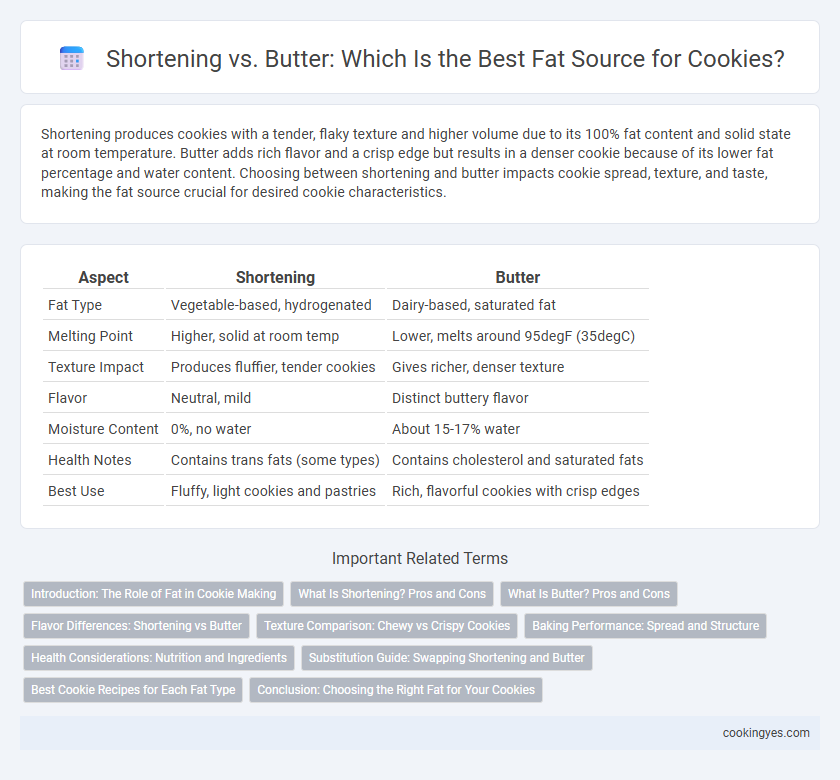Shortening produces cookies with a tender, flaky texture and higher volume due to its 100% fat content and solid state at room temperature. Butter adds rich flavor and a crisp edge but results in a denser cookie because of its lower fat percentage and water content. Choosing between shortening and butter impacts cookie spread, texture, and taste, making the fat source crucial for desired cookie characteristics.
Table of Comparison
| Aspect | Shortening | Butter |
|---|---|---|
| Fat Type | Vegetable-based, hydrogenated | Dairy-based, saturated fat |
| Melting Point | Higher, solid at room temp | Lower, melts around 95degF (35degC) |
| Texture Impact | Produces fluffier, tender cookies | Gives richer, denser texture |
| Flavor | Neutral, mild | Distinct buttery flavor |
| Moisture Content | 0%, no water | About 15-17% water |
| Health Notes | Contains trans fats (some types) | Contains cholesterol and saturated fats |
| Best Use | Fluffy, light cookies and pastries | Rich, flavorful cookies with crisp edges |
Introduction: The Role of Fat in Cookie Making
Fat plays a crucial role in cookie making by influencing texture, flavor, and spread. Shortening, composed of pure fat, creates a tender, crumbly texture with less spread due to its solid structure, while butter contributes a rich flavor and promotes spreading because of its water content and melting properties. Selecting the right fat source affects moisture retention, mouthfeel, and overall cookie quality, making it essential to balance desired characteristics in recipe formulation.
What Is Shortening? Pros and Cons
Shortening is a solid fat made from vegetable oils that is commonly used in cookies to create a tender, crumbly texture due to its 100% fat content and lack of water. It helps produce cookies that hold their shape better during baking and results in a softer, more consistent crumb compared to butter. However, shortening lacks the rich flavor and moisture that butter provides, and it often contains trans fats, which are considered less healthy.
What Is Butter? Pros and Cons
Butter is a dairy product made from churning cream, offering a rich flavor and natural moisture to cookies. It contains about 80% fat and adds a tender texture and golden color, but its water content can cause cookies to spread more during baking. Butter's distinctive taste enhances cookie flavor, though it may result in less crispness compared to shortening, which contains no water and produces a fluffier texture.
Flavor Differences: Shortening vs Butter
Butter imparts a rich, creamy flavor to cookies due to its natural milk solids and slight caramelization during baking, enhancing the overall taste profile. Shortening provides a more neutral taste, allowing other ingredients to dominate without introducing butter's distinctive flavor. Choosing butter over shortening results in cookies with deeper, more complex flavor notes, while shortening yields a milder, less flavorful cookie.
Texture Comparison: Chewy vs Crispy Cookies
Shortening creates cookies with a tender and chewy texture due to its higher melting point, preventing the cookies from spreading too much during baking. Butter, with its lower melting point and water content, often produces crispier edges and a more uneven, crunchy texture. Choosing shortening favors soft, dense cookies, while butter results in crisper, thinner cookies with a richer flavor profile.
Baking Performance: Spread and Structure
Shortening provides superior baking performance in cookies by creating less spread and a thicker, more tender structure due to its higher melting point compared to butter. Butter's lower melting point causes cookies to spread more during baking, resulting in a thinner, crisper texture with richer flavor. The choice between shortening and butter significantly impacts cookie texture and appearance, with shortening delivering consistent structure and butter enhancing flavor complexity.
Health Considerations: Nutrition and Ingredients
Shortening contains no cholesterol and has a higher melting point, resulting in crispier cookies but often includes trans fats linked to heart health risks. Butter provides natural vitamins A and E, along with healthier fats, but adds saturated fat and cholesterol, which may impact cardiovascular health. Choosing butter supports a more natural ingredient profile, while shortening may affect texture and shelf life, requiring careful consideration of nutritional implications.
Substitution Guide: Swapping Shortening and Butter
When substituting shortening for butter in cookies, use a one-to-one ratio to maintain texture and structure, but expect a slightly softer, less flavorful result because shortening contains no water and less milk solids. Replacing butter with shortening increases cookie spread resistance and tenderness due to shortening's higher melting point and 100% fat content. For a butter replacement, be aware that cookies may lack the rich, creamy flavor and crisp edges characteristic of butter-based recipes.
Best Cookie Recipes for Each Fat Type
Shortening creates cookies with a tender, airy texture due to its 100% fat content and absence of water, ideal for classic sugar cookies and soft chocolate chip varieties. Butter, containing about 80% fat and natural water, offers richer flavor and a slightly crisp edge, perfect for buttery shortbread and caramel-topped cookies. Recipes using shortening often yield thicker, chewier cookies, while butter-based recipes produce crispier, more flavorful results.
Conclusion: Choosing the Right Fat for Your Cookies
Choosing the right fat for cookies depends on the desired texture and flavor; butter offers rich taste and browning through milk solids, while shortening provides a higher melting point for softer, thicker cookies. Butter-based cookies tend to spread more and have a crisp edge, whereas shortening creates a tender, crumbly crumb with less spread. For optimal results, a blend of butter and shortening balances flavor and texture, producing cookies with both richness and stability.
Shortening vs butter for cookie fat source Infographic

 cookingyes.com
cookingyes.com